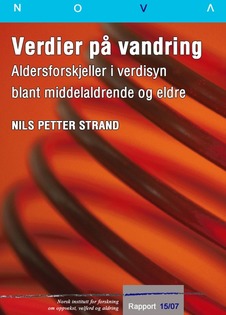| dc.description.abstract | The focus is in this report on differences in value orientations between middle-aged and older people. Two main research questions will be addressed: (1) How, and to what degree, do social value differ between age groups? (2) Are age differences in value orientations a result of generation or life-phase effects? A third question concerns the validity of the main research instrument, Portrait Value Questionnaire (PVQ), in a Norwegian context.The analysis is based on data from the Norwegian Life-Course, Ageing, and Generation Study (NorLAG), collected during 2002 and 2003. The NorLAG survey focuses on a variety of life domains in the second half of life. The study is conducted by NOVA, while the data collection is carried out by Statistics Norway (SSB). The sample basis for this report is 4 169 persons born between 1922 and 1961. In other words, the respondents were between 40 and 81 years old when they were interviewed The validation analysis of PVQ demonstrates that the instrument functions close to what is expected in theory. The instruments two theory-based value dimension correspond well with the two factors derived from a factor analysis of the PVQ items. However, a factor rotation demonstrates that there are open areas in the two-dimensional value space, which indicates that some values may be poorly represented by the instrument. The analyses display clear value differences between age groups along one of the two main dimensions, conservation–openness to change. The respondents in general hold more conservation-oriented values the older they are, and more change-oriented values the younger they are. Compared to other background variables such as gender, education, income and type of living area, age has considerable effect on values along the conservation–openness to change dimension. Only education level has a stronger effect. Along the other main dimension, self enhancement–self transcendence, the age differences are close to insignificant. The analyses furthermore indicate that the value differences are rather balanced between age groups, which means that there are no sign of any period with particularly strong value change. Cross-sectional analyses leave limited opportunity for separating generation and life-phase effects. However, the results strongly indicate that there are considerable generation (cohort) effects, in particular as a consequence of the higher education level among the younger cohorts. One fifth of the age effect on the conservation–openness to change dimension is caused by education as an intervening variable, which must be considered as a generation (cohort) effect. Life-phase effects are found to be minimal, but the data indicate that retired respondents in the 60s are more conservation-oriented than their working peers, which can be seen as a life-phase effect. The findings indicate that conservation-oriented values such as conformity, tradition and security have high priority among all age groups between 40 and 80. Nevertheless, the status of these values is gradually weakened by younger generations giving higher priority to self-stimulating and change-oriented values such as hedonism, stimulation and self-direction. | en |
| dc.description.abstract | Rapporten tar for seg forskjeller i verdiorientering i alderen 40-80 år: Endrer verdiene seg med alderen, eller kan forskjellene forklares ved at man er preget av ulike generasjonserfaringer? Studien bygger på data fra Den norske studien av livsløp, aldring og generasjon (NorLAG), en tematisk bred studie av personer i andre halvdel av livet. I NorLAG måles verdiorientering med det internasjonalt benyttede målinstrumentet Portrait Value Questionnaire (PVQ). Validiteten av instrumentet for norske forhold undersøkes også i rapporten, og analysene viser at det fungerer temmelig nær det teoretisk forventede. Undersøkelsen viser forøvrig at de eldre aldersgruppene setter konserverende verdier som tradisjon, konformitet og trygghet høyere enn de middelaldrende. Sammenlignet med andre bakgrunnsvariabler som kjønn, utdanning, inntekt og boligtetthet har alder en kraftig effekt på verdiorientering. Blant personer med samme utdanningsnivå er aldersforskjellene mindre. Generelt tyder resultatene på at konserverende verdier som konformitet, tradisjon og trygghet står sterkt i samtlige undersøkte aldersgrupper, men disse verdienes stilling i samfunnet svekkes gradvis som følge av at hver nye generasjon gir stadig høyere prioritet til selvstimulerende og endringspositive verdier som hedonisme, stimulering og uavhengighet. | no_NB |
